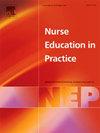西班牙语版护理一年级学生自我评估实习量表的验证
IF 3.3
3区 医学
Q1 NURSING
引用次数: 0
摘要
目的评价西班牙语版学生自我评估实践量表(SaPS)在智利一年级护理专业学生中的效度和信度。自我评估是学生根据预先设定的标准对自己的工作和学习过程以及自己的成就程度做出判断的过程。这个过程在学习中是至关重要的,因为它可以让学生纠正错误,提高他们的表现。西班牙语中没有专门设计的工具来测量护理学生的自我评估过程,因此该过程在该人群中的发展和特征是未知的。MethodsCross-sectional研究。采用翻译-反翻译程序。10位专家对题目的内容效度进行了评估。在将此工具适应西班牙语境后,它被应用于172名大学护理学生。采用探索性因子分析(EFA)对该仪器的内部结构进行了研究,并用Cronbach’s α系数对其进行了信度评价。结果经专家分析,保留仪器原有的20个项目。EFA结果显示3个因素和17个项目适合在护生中使用;该版本sap的总体信度为α = 0.73。各子量表的信度系数为:a寻求外部反馈(SEF) α= 0.61,寻求内部反馈(SIF) α= 0.72;和自我反思(SR), α = 0.75。结论本研究提供证据支持西班牙语版sap在护理学生中使用的有效性和可靠性。本文章由计算机程序翻译,如有差异,请以英文原文为准。
Validation of the Spanish version of the self-assessment practice scale in first-year nursing students
Aim
To evaluate the validity and reliability of the Spanish version of the Self-Assessment Practice Scale for Students (SaPS) in first-year nursing students in Chile.
Background
Self-assessment is a process by which students make a judgment about their work and learning process, as well as about their degree of achievement based on pre-established criteria. This process is crucial in learning because it allows students to correct errors and improve their performance. There are no instruments in Spanish specifically designed to measure the self-assessment process in nursing students, so the development and characteristics of this process in this population are unknown.
Methods
Cross-sectional study. A translation-back-translation procedure was used. Ten experts evaluated the content validity of the items. After adapting this instrument to the Spanish context, it was applied to 172 university nursing students. The internal structure of this instrument was studied using exploratory factor analysis (EFA) and its reliability was evaluated in terms of Cronbach's α coefficients.
Results
After expert analysis, the original 20 items included in the instrument were retained. EFA revealed that 3 factors and 17 items were suitable for use with nursing students; the overall reliability of this version of the SaPS was α = 0.73. The reliability coefficients for the subscales were: a Seeking external feedback (SEF) α= 0.61, seeking internal feedback (SIF) α= 0.72; and self-reflection (SR), α = 0.75.
Conclusions
This study provides evidence to support the validity and reliability of a Spanish version of the SaPS for use with nursing students.
求助全文
通过发布文献求助,成功后即可免费获取论文全文。
去求助
来源期刊

Nurse Education in Practice
NURSING-
CiteScore
5.40
自引率
9.40%
发文量
180
审稿时长
51 days
期刊介绍:
Nurse Education in Practice enables lecturers and practitioners to both share and disseminate evidence that demonstrates the actual practice of education as it is experienced in the realities of their respective work environments. It is supportive of new authors and will be at the forefront in publishing individual and collaborative papers that demonstrate the link between education and practice.
 求助内容:
求助内容: 应助结果提醒方式:
应助结果提醒方式:


